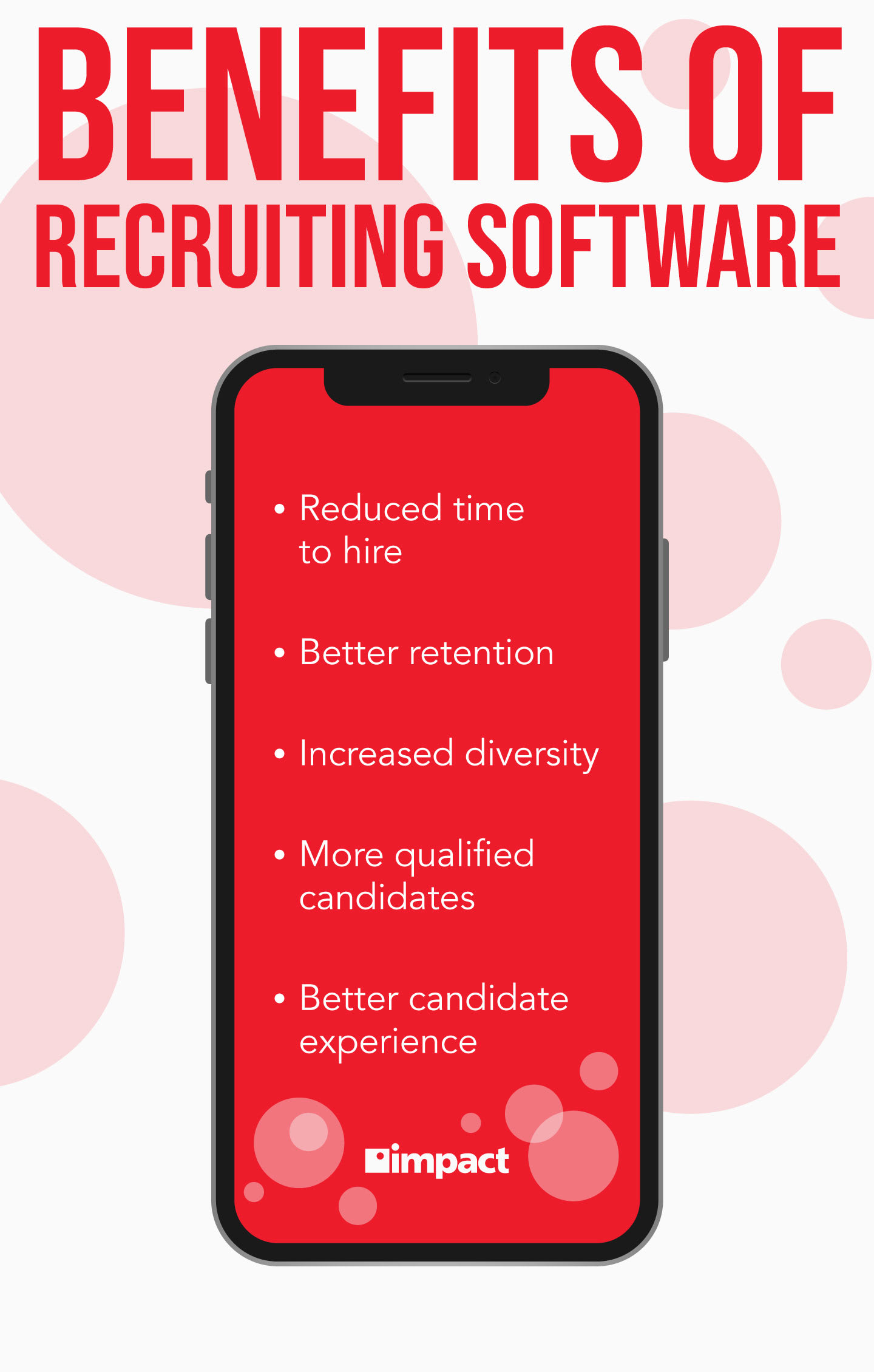People always have and always will be at the heart of any organization. This is why recruiting and hiring practices are so vital to building a successful business that boasts a strong culture with experts who don’t just do their job, but are also easy to work with and highly collaborative. Recruiting software can help businesses big and small find, and more importantly keep, the right people for the role.
Recruiting software for small businesses is especially helpful because it eases the burden on the often-small HR department, allowing them to focus on conducting high-quality interviews, internal initiatives, and nurturing a strong company culture.
Recruiting software can automate certain workflows, ease candidate communication, and streamline the entire recruitment and hiring pipeline.
To learn about other ways that organizations are using technology to ease processes and streamline workflows, watch Impact’s webinar, How Managed Digital Transformation Solves Real Challenges | An Inside Look.
How Recruiting Software Works
Recruiting software streamlines the hiring process by automating and organizing key tasks, making it easier for small businesses to find and hire the right candidates. It allows employers to create job postings, track applications, and manage communications with candidates in one platform.
The software integrates with job boards, like Indeed and LinkedIn, allowing businesses to post across multiple platforms with just a few clicks. Once applications come in, it sorts and filters candidates based on skills, qualifications, and other criteria, saving time and reducing manual effort.
Additionally, recruiting software enhances collaboration by allowing team members to review and provide feedback on candidates through a shared interface. It includes tools for scheduling interviews, sending automated follow-up emails, and conducting background checks.
More advanced platforms offer analytics that track the efficiency of the hiring process, such as time-to-hire and cost-per-hire metrics, providing insights that can improve future recruiting efforts. This technology enables small businesses to compete for top talent with larger companies by managing the recruitment process in a more organized, scalable, and professional manner.
Key Features to Look for in Recruiting Software
When selecting recruiting software, HR professionals should prioritize several key features that will streamline the hiring process and improve overall efficiency.
- Applicant Tracking System (ATS): An ATS enables HR professionals to track candidates at every stage of the pipeline, organize applications, and automate repetitive tasks like resume screening and interview scheduling.
- Customizable Workflows and Automation: Automation is critical in reducing the time spent on administrative tasks, such as sending follow-up emails or scheduling interviews. HR professionals should seek software that allows for customizable workflows, letting them tailor processes to meet the specific needs of their business.
This flexibility ensures that the recruitment process aligns with company policies while maintaining consistency across roles and departments.
- Integration with Job Boards and Social Media: This feature allows HR teams to post job listings on numerous channels simultaneously, expanding visibility without the need to manually update each platform.
Additionally, integration with LinkedIn or other social sites can help streamline the passive recruiting process by making it easier to connect with potential candidates directly.
- Collaboration Tools for Team Hiring: Features like shared notes, rating systems, and comment sections allow hiring managers, recruiters, and other stakeholders to provide real-time feedback on candidates, ensuring that decisions are made efficiently and with input from all relevant parties. This fosters a more transparent and collective hiring process.
- Reporting and Analytics: Finally, data-driven insights are crucial for refining recruiting strategies over time.
These tools provide valuable metrics such as time-to-hire, cost-per-hire, and the effectiveness of different job boards, helping teams identify bottlenecks and optimize their recruitment efforts for better long-term results.
Common Mistakes to Avoid with Recruiting Software
When using recruitment software, users can inadvertently undermine the efficacy of the tool by making common mistakes that hinder the hiring process.
- Over-Automation: While automation is a powerful feature of recruitment software, relying too heavily on it can lead to missed opportunities or overlooked talent. Automated resume screening and keyword filters are useful for managing large volumes of applicants, but they can sometimes exclude qualified candidates who don’t perfectly match the set criteria.
Users should strike a balance by manually reviewing shortlisted candidates or adjusting filters to ensure they don’t miss out on high-potential applicants who might bring valuable skills or diverse experiences to the team.
- Failing to Customize: Many users make the mistake of not customizing the recruitment software to align with their unique hiring processes. Most platforms offer flexible workflows, but if businesses don’t tailor these settings to their specific needs, they risk creating inefficiencies.
For example, not setting up custom stages in the hiring pipeline or neglecting to configure automated notifications can cause delays in candidate communication or create confusion among team members. Customizing the software ensures that it fits the business’ hiring pace, roles, and team structure, improving overall efficiency.
- Inconsistent Use: A common mistake is not ensuring that all team members use the recruitment software consistently. When hiring managers, recruiters, and HR personnel are misaligned on platform use, it can result in incomplete candidate data, miscommunication, or delays in the decision-making process.
For example, if one team member skips a step in the candidate evaluation workflow, important feedback might be lost, leading to confusion or redundancy. Establishing clear guidelines and training for all users ensures that the recruitment software is used effectively and consistently, promoting a smoother hiring process.
3 Benefits of Using Recruiting Software as a Small Business
Recruitment software offers numerous benefits that can greatly enhance the hiring process for businesses of all sizes. One of the most significant advantages is increased efficiency.
By automating repetitive tasks such as resume screening, interview scheduling, and communication with candidates, recruitment software saves time and reduces administrative burdens. This allows HR teams to focus on higher-value activities like interviewing and engaging with top talent, ultimately speeding up the time-to-hire and reducing the risk of losing qualified candidates to competitors.
Another key benefit is improved organization and collaboration. Recruitment software centralizes all hiring-related information in one platform, making it easy for team members to access candidate profiles, track progress, and share feedback.


